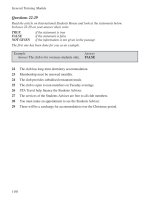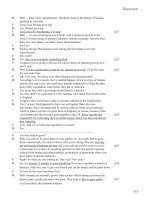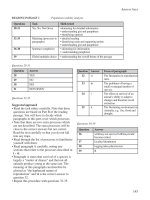Cambridge Practice Tests for IELTS part 11
Bạn đang xem bản rút gọn của tài liệu. Xem và tải ngay bản đầy đủ của tài liệu tại đây (2.64 MB, 12 trang )
145
Answer keys
READING PASSAGE 3 Population viability analysis
Questions 28-31
Questions 32-35
Suggested approach
• Read the task rubric carefully. Note that these
questions are based on Part B of the reading
passage. You will have to decide which
paragraphs in this part cover which processes.
• Note that there are two extra processes which
are not described. The extra processes will be
close to the correct answers but not correct.
Read the text carefully so that you do not fall
into any traps.
• Read through the list of processes to familiarise
yourself with them.
• Read paragraph A carefully, noting any
sections that relate to the processes described in
i - vi.
• Paragraph A states that survival of a species is
largely a “matter of chance” and that not all
animals produce young at the same rate. The
meaning of this paragraph can therefore be
glossed as “the haphazard nature of
reproduction” and vi is the correct answer to
question 32.
• Repeat this procedure with questions 33-35.
Questions 36-39
AnswerQuestion
will/may not survive//will/may/could
become extinct
36
locality//distnbution
logging takes place/occurs
B
37
38
39
Answer
YES
NO
NO
NOT GIVEN
Question
28
29
30
31
Question Answer Focus of paragraph
32 vi The fluctuation in reproduction
rates.
33 iii The problems of having a
small or unequal number of
one sex.
34 i The effect on survival of an
animal’s ability to adapt to
changes and therefore avoid
extinction.
35 ii The fluctuating environment in
Australia, e.g. fire, flood and
drought.
Questions Task Skills tested
28-31 Yes, No, Not Given •skimming for detailed information
• understanding gist and paraphrase
• identifying opinion
32-35 Matching (processes to
paragraphs)
• detailed reading
• identifying main and supporting points
• understanding gist and paraphrase
36-38 Sentence completion • skimming for information
• understanding paraphrase
39 Global multiple choice • understanding the overall theme of the passage
146
GENERAL TRAINING
General Training
Questions 9-14
Suggested approach
• Read the task rubric carefully. Only one option
(A-D) is correct in each case.
• Read question 9 and the four options.
• Scan the headings in the text to see if any of
them are about seating on the coach. The
section entitled “Seat Allocation” refers
specifically to this.
• Skim through that section of the text and find
out what you have to do if you want to sit at the
front of the coach.
• This paragraph focuses entirely on the
importance of booking early if you want a
particular seat. So the answel to question 9 is C.
READING MODULE
PART 1
Questions 1-8
Although all the other options are possible,
only C is stated in the text.
• Repeat this procedure with questions 10-14.
Questions Task Skills tested
1-4 Matching (pictures to
text)
• detailed understanding of a section of text
• understanding description of parts and their uses
• identifying pictorial representation of text
5-8 Short-answer questions • skimming for specific information
• understanding description/characteristics
• understanding paraphrase
9-14 Multiple choice • skimming/scanning for specific information
• understanding paraphrase
• distinguishing between main and supporting points
Answer
D
A
C
E
distilled (water)
the (type of) fabric
turn up/increase temperature
calcium deposits//furring up
Question
1
2
3
4
5
6
7
8
Question Answer Location of answer in text
9 C “Requests for particular seats
can be made on most coach
breaks when booking …”
10 D “… air or boat tickets may
have to be retained and your
driver or courier will then issue
them to you at the relevant
point.”
11 C “If you require a special diet
you must inform us at the time
of booking …”
12 A “Other coach breaks have a
limited number of rooms with
private facilities … the
supplementary charge shown
in the price panel will be added
to your account.”
13 B “The … entertainment …
could be withdrawn if there is
a lack of demand …”
14 B “… a small holdall can also be
taken on board the coach.”
147
Answer keys
PART 2
Question 15-21
Questions 22-29
Suggested approach
• Read the task rubric carefully. Note that you
have to make a judgement about the list of
statements.
• Note the difference between information that is
false (i.e. the passage says the opposite) and
information that is not given (i.e. not stated in
the passage at all).
• Read question 22. This statement is about
overnight accommodation.
• Scan the paragraph headings for a reference to
accommodation. The first heading is
“Accommodation”
• Skim through this section of the text to see if
there is any information about how long you
can stay at the club for. At the end of the
section it states: “long and short stays
welcomed”. So the answer to question 22 is
True.
• Repeat this procedure with questions 23-29.
Question Answer Location of answer in text
22 T “long and short stays
welcomed”
23 F “You can join the Club … for
up to one year at a time.”
24 NG
25 T Gist of last part of Membership
section.
26 T “Thanks to the support of STA
travel … International Students
House now provides the
services of an International
Students Adviser.”
27 NG
28 NG
29 F “… the club will be offering
reduced accommodation rates
for students wishing to spend a
few days in London over
Christmas.”
Answer
E
D
A
E
A
B
F
Question
15
16
17
18
19
20
21
Questions Task Skills tested
15-21 Matching (requirements
to clubs)
• skimming/scanning for specific information
• understanding paraphrase
• making inferences
22-29 True, False, Not Given • skimming/scanning for specific information
• distinguishing between what is clearly stated and what is
not stated.
• understanding paraphrase and gist
148
General Training
PART 3
Questions 30-36
Suggested approach
• Read the task rubric carefully.. You have to
complete the summary by filling in the spaces
with words from the passage. The words must
fit in meaning and also be grammatically
correct.
• Read the summary to familiarise yourself with
it. It may be possible to find words without
reading the original text, but if you do this you
may pick words which are not in the text, in
which case your answer will be incorrect. So
you must look for a word within the passage
which has the right meaning and which is the
correct part of speech for the space.
• Read the first item in the summary.
• Look at the text and see if you can find the
same information there. For item 30, the first
sentence discusses the qualities of paper that
make it different from other waste products.
The text states that paper comes from a
“sustamable resource”. So “sustamable” is a
correct answer.
• Sometimes there are alternative answers that
are correct in this type of question. For item 30,
“replaceable” is also a possible answer because
it says a little further on in the text, “trees are
replaceable”.
• Note however that “renewable” is not an
acceptable answer because although it is a
synonym and makes sense, it is not in the
original text.
Questions 37-41
Question
30
Location of answer in text
“Paper … comes from a
sustamable resource …”
Answer
sustamable//
replaceable
31 “Paper is also
biodegradable, so it does
not pose as much threat to
the environment when it is
discarded.”
biodegradable
32 “… the rest comes directly
from virgin fibre …”
virgin fibre/
pulp
33 “Governments have
encouraged waste paper
collection and sorting
schemes …”
governments
//the
government
34 “… advances in the
technology required to
remove ink …”
advances
35 “We need to accept a
change in the quality of
paper products”
quality
36 “… it also needs to be
sorted from contaminants
contaminants
Answer
offices
sorted
(re)pulped
de-ink/remove ink//make white
refined
Question
37
38
39
40
41
Questions Task Skills tested
30-36 Summary completion • skimming for information
• understanding paraphrase
• rewording text
37-41 Flow chart completion • skimming for specific information
• following a process
• summarising ideas
149
Answer keys
WRITING: MODEL ANSWERS
ACADEMIC WRITING MODULE
Practice Test 3, Writing Task 1
You should spend about 20 minutes on this task.
The chart below shows the amount of money per week spent on fast foods
in Britain. The graph shows the trends in consumption of fast-foods.
Write a report for a university lecturer describing the information shown
below.
You should write at least 150 words.
Model answer 165 words
The chart shows that high income earners consumed considerably more fast
foods than the other income groups, spending more than twice as much on
hamburgers (43 pence per person per week) than on fish and chips or pizza
(both under 20 pence). Average income earners also favoured hamburgers,
spending 33 pence per person per week, followed by fish and chips at 24 pence,
then pizza at 11 pence. Low income earners appear to spend less than other
income groups on fast foods, though fish and chips remains their most popular
fast food, followed by hamburgers and then pizza.
From the graph we can see that in 1970, fish and chips were twice as popular as
burgers, pizza being at that time the least popular fast food. The consumption of
hamburgers and pizza has risen steadily over the 20 year period to 1990 while the
consumption of fish and chips has been in decline over that same period with a
slight increase in popularity since 1985.









